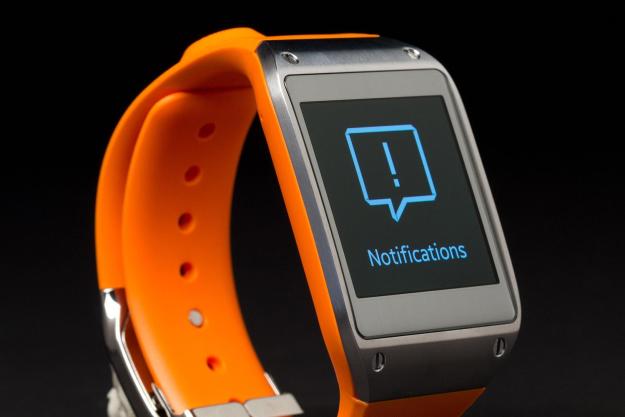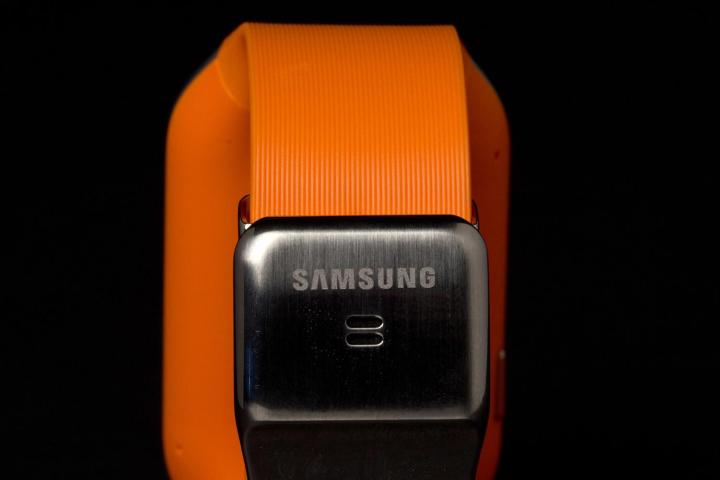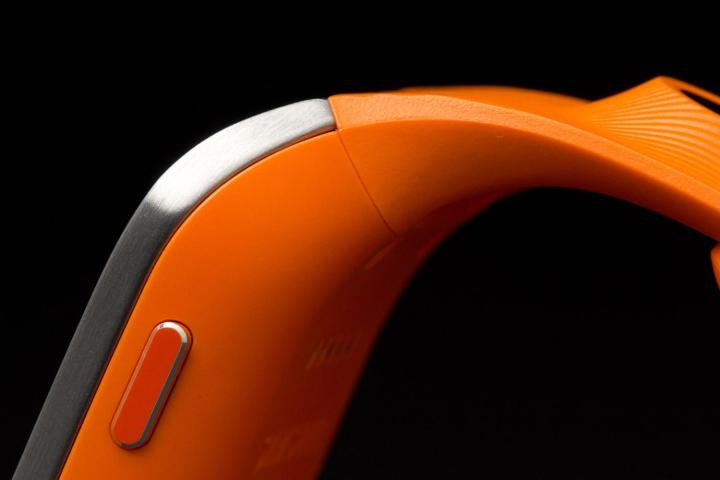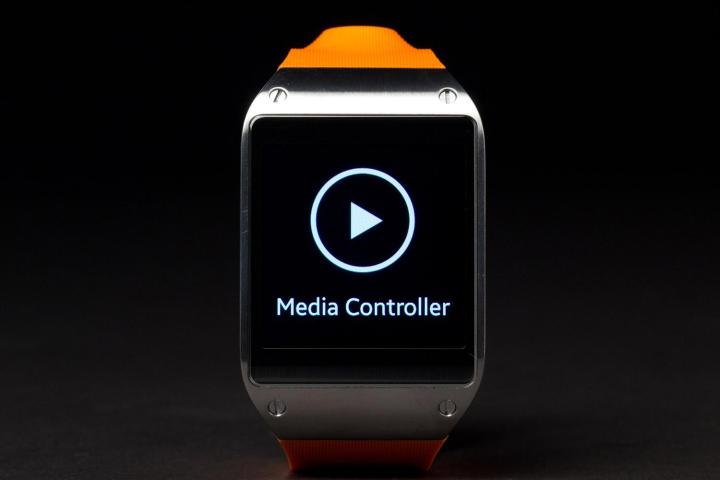
“Samsung’s Galaxy Gear is a nice-enough proof of the smartwatch concept, and excels as a wrist-mounted speakerphone. But its notification system is broken beyond text messages, and the screen is too slow to switch on when you raise it to your wrist.”
- Screen looks good and is readable in sunlight
- Making phone calls works well in quiet environments
- Good build quality
- Only compatible with 2 Samsung devices
- Gesture control for turning on screen is slow
- Notifications lack essential details
- Clamp-on shell required for (daily) recharging
- NFC chip for pairing lives in the charger, not the watch
- Few compatible apps
Rumors of an Apple iWatch arguably kicked off the current smartwatch craze, but news on that front has been relatively quiet as of late – from Apple, at least. It’s competitors, on the other hand, aren’t keen to sit around and wait. And so we have the $300 Galaxy Gear. Samsung’s first smartwatch is now a buyable product with a nice-looking screen and some unique features, like a built-in camera, a gyroscope that switches on the screen when you flip up your wrist, and the ability to make calls, take calls, and send texts without pulling out your Samsung smartphone.
For the Gear to be useful, it has to be able to tell you who’s trying to get your attention. At the moment, at least, the Gear fails hard.
But while Sony’s device is splash-proof and reportedly has a battery that will last a few days (versus the Gear’s 25 hours), it has a lower-resolution screen than Samsung’s watch. And neither the Sony nor the Pebble has a camera or the ability to make phone calls from your wrist without taking your phone out of your pocket or bag.
So while the Galaxy Gear is far from alone in the burgeoning smartphone market, it’s certainly one of the more ambitious devices when it comes to features. But this is Samsung’s first attempt at a smartwatch, so not all those features work well.
A nice enough design
Samsung certainly knows how to make an attractive consumer product, and the Gear is no exception. The watch’s 1.63-inch glass-covered screen is surrounded by curved stainless steel and a quartet of small screws, which we hope means the device won’t be a nightmare to repair. We would be happy, though, for a bit less bezel around the screen.
The screen itself isn’t curved, which is a disappointment, and makes for a device that’s less comfortable than some watches. But even though it’s been years since we’ve worn a watch, we quickly got used to wearing the Gear.
Still, while the Gear didn’t feel large or cumbersome on our wrist, at 0.43 inches thick, 1.46 inches wide, and 2.24 inches long, it may not be all that appealing to those with small wrists.
Any wearable device is at least partially a fashion statement, and so the Gear’s rubbery wrist straps are available in six colors. In an apparent attempt to make sure we stood out when using the device, we wore the bright-orange model.
You’re better off reaching for your smartphone to take pictures.
To charge the Gear, you must clamp the watch’s face inside a plastic cradle, which you then plug in via a standard Micro USB port. Once you get used to it, clamping the phone into the cradle only takes 15 seconds or so. But considering you’ll need to do this every night, and remove the watch every morning, it’s far from ideal. We applaud Samsung for using a standard Micro USB port so you don’t need to carry around a separate charger when traveling. But the port really should be somewhere on the watch itself.
An adequate screen and ‘ok’ camera
The Gear’s 1.63-inch AMOLED display is bright and crisp, with a resolution of 320 x 320 pixels, which bests Sony’s Smartwatch 2 (220 x 176), and has good viewing angles. While that’s far from HD, content on the phone’s small screen looks good, leaving little room for complaints.
The camera on the wrist strap is a 1.9 megapixel shooter, which means it won’t replace your smartphone’s camera. But the pictures we took with the Gear look reasonably good, though there is more noise than we’re used to from current smartphones. The Gear can also shoot short 720p videos, which also work well for social media sharing.
Really, though, you’re better off reaching for your smartphone to take pictures. We’re much more interested to see what app developers are able to do with the Gear’s camera. The Vivino Wine Scanner app is already available. It lets you snap a picture of a wine bottle to get details about that particular Chardonnay or Shiraz, We hope to see plenty of other apps that use the camera in interesting ways. Until then, though, the Gear’s camera is a differentiator, but not a selling point.
Factory reset, pair, and talk like Dick Tracy
You’ll need a Galaxy Note 3 smartphone (or a Galaxy Note 10.1 2014 Edition tablet) to pair (via Bluetooth) with the Gear at launch. The list of compatible devices will no-doubt grow over time. In fact, we were able to install the Gear manager app from Samsung’s app store on our Galaxy S4, pair the two devices, and run the native Samsung apps. But third-party apps would not install. So for the purposes of this review, we’ll focus on pairing with and using the Gear with the Galaxy Note 3.
Remember the charging cradle we mentioned earlier? It houses an NFC chip that lets you pair the Gear with the Note 3 fairly easily. But again, we’d rather have the NFC chip inside the watch, where it could be used by app developers to create novel features.

Place the back of the Gear’s cradle to the back of the Note 3 phone, accept the pairing on both the Gear and the Note, and you’re done. Alternatively, you can also pair the Gear with the Note 3 via the more traditional method of tapping in a passcode.
Pairing the watch is a pain. To pair the Gear with a different phone (as we did with our Galaxy S4), it must first perform a factory reset. This only took a couple minutes, but struck us as odd. If you leave the Gear manager app installed on your phone, though, it will restore your old settings and apps on the Gear after the reset, which is nice.
Once you’re paired, one of the novel things you can do with the Gear is make phone calls from your wrist, Dick Tracy style. You can do this via a dialer number pad, by scrolling through the Contacts app, or via Samsung’s Siri-like S Voice. All three work reasonably well, although dialing (or sending texts) via S Voice only works if you’re in a quiet environment.
If you use the Gear to make or take calls, you’ll probably want to be alone. After all, you’ll be talking over a speakerphone. The Gear has a pair of pinhole microphones on the right and left side, and the speaker is part of the metal clasp on the other side of your wrist.
We made a couple of calls this way and, again, provided you’re in a quiet environment, it works. The speaker is loud enough to hear the conversation without having to hold it near your ear, and we were told on the other end that our voice was coming through loud and clear, even with our wrist held a few feet away from our face.
Another caveat: You might think that the Gear will then let you take phone calls while you work. But as we discovered, if you’re typing while trying to hold a conversation, the clackity clacking is picked up quite clearly by the mic, along with your voice. That’s not necessarily surprising, given the Gear is strapped directly to your wrist. But it does make the Gear a less-than-ideal speakerphone to use at your office desk.
Specs, battery life, & basic use
Likely because of battery life issues, the Gear has a meager-sounding 800MHz single-core processor powering it, and 4GB of internal storage. Since you won’t store much beyond apps and a few photos and videos on the device, 4GB feels like enough, especially since you can transfer your media over to the phone wirelessly.
Battery: Samsung readily admits you’ll need to charge the Gear daily, promising 25 hours of battery life. We think that’s generous if you’re awake for all those hours and using the watch regularly, but not far off the mark. Using the device on the weekend, when we got far fewer notifications than a normal weekday, we drained the battery down below 50 percent in about 12 hours. So yes, you’ll need to charge the Gear every day, but it shouldn’t go dead on you before you get home, unless the sun’s already up again when you reach your front door.
Flick your wrist, turn on your watch?
The Gear also has a gyroscope and accelerometer, which lets the device work as a pedometer. But more importantly, this pairing lets you turn on the screen simply by flicking raising your wrist up to an eyeball-friendly position. In theory, this is great; if the screen were on all the time, battery life wouldn’t last much beyond a couple of hours. And while you can switch the screen on using the Gear’s single button on the right side of the screen, that requires a free hand and, for us, at least, also often resulted in pinched arm hairs.

In practice, switching on the screen with the flick of a wrist is a mixed bag. It doesn’t work when lying down, as Samsung warns in the documentation. But more annoyingly, while you don’t have to flick your wrist in an exaggerated manner to get the screen to switch on, it just doesn’t switch on fast enough. Raise the Gear up to look at the screen and it takes close to a second before the screen switches on. That may not sound like much, but it’s fairly frustrating in a $300 device whose main purpose is to let you glance at the time and notifications without having to take a smartphone out of your pocket or purse.
We really, really hope that Samsung can improve this issue via software updates, because while we got more used to the screen delay over time, it was a constant reminder that the Gear just isn’t as good as we’d like it to be for the most basic of tasks, like checking the time.
It comes with a few different apps and watchfaces
Aside from the screen not switching on as fast as we’d like, the Gear’s performance isn’t bad. It’s certainly not as snappy as a high-end, or even a good mid-range multi-core smartphone. But in swiping through and launching apps, the Gear didn’t feel frustratingly laggy with our time with it. And we never experienced any app crashes or visual glitches with the core Samsung apps.
Navigating the Gear’s OS is fairly straightforward. Form the home/watch screen, you swipe from the top down to bring up the camera, and swipe down again to go back Home. Swiping left or right scrolls through the built-in apps. The first app when swiping left to right is Contacts, while swiping in the opposite direction brings up Notifications.
While the Gear didn’t feel overly large or cumbersome, it may not appeal to those with small wrists.
You won’t have to dive deeply into the Gear’s menus to see your next appointment, though. One of the available clock faces always shows your next appointment, and other faces give you your daily step count (from the pedometer) and the day’s weather.
As you might expect, given how new the Gear is, there aren’t many third-party apps. If you don’t count extra clock faces (some of which are nice), there are roughly 25 extra apps available for the Gear, accessible via a separate app store inside the Gear Manager app. There’s Evernote and Pocket, both of which aren’t well suited to the Gear’s small screen, and some simple apps that offer stuff like a virtual Spin the Bottle game (we’re so glad that’s covered).
There are also a few fitness apps, and a dozen or so apps in the Social Media section. There’s a Snapchat app (presumably for after a couple games of Spin the Bottle), too.
Notification fail
The biggest problem with the Gear’s built-in apps—indeed arguably its biggest problem overall, lies in the Notification app. This is where you’ll get your at-a-glance info that’s supposed to keep you from having to grab your phone every time you get a text, a call, a Facebook update, or a tweet.
With text messages and phone calls, this works, displaying who’s calling/texting (provided they’re in your address book). With texts, you can even scroll through the message with the swipe of a finger.
Other notifications, though, are essentially useless. Get a Gmail message, a Facebook comment, or a Twitter message, and the Gear just tells you the message type, with none of the content. You’ll know, say, that someone emailed you, but not who or why.
Frankly, it baffled us that most alert types don’t at least tell you who they’re from. We reached out to Samsung, who confirmed that, beyond texts and phone calls, notifications just point you to your phone for more info.
When you tap on one of these notifications on the Gear, your phone will open directly to the requisite app and message, which is nice. But for the Gear to be useful as glance-able filter in a digital world drowning in notifications, it has to be able to tell you who’s trying to get your attention. At the moment, the Gear fails on that front, and it fails hard. It seems plausible that this could be fixed via an app update. But Samsung gave us no indication that such an update was on its way anytime soon or, indeed, ever.
There are a few apps that try to make up for the Gear’s failings, and offer notifications for Facebook and Twitter. If they worked, this would make the Gear more useful. But when we tried both Tweet Quickview and FBQuickview, the latter crashed before we even tried opening it on our Gear, and the former brought up a blue splash screen, hung there until the screen timed out, then crashed the second time we tried to launch it.
Conclusion
The Samsung Galaxy Gear is a ‘nice-enough’ piece of hardware that’s comfortable to wear and delivers enough battery life to get you through the day. Its core apps look good, feel stable, and prove that getting notifications on your wrist is a feature worth paying for.
But without delivering useful information for most types of messages, the Gear feels frustratingly limited. The screen needs to power on faster when you raise it to your wrist, and the company needs to ditch the charging cradle for an on-board Micro USB port and built-in NFC.
The lack of support for nearly anything other than the Note 3 or Note 10.1 2014 Edition is also an issue that needs fixing. But considering the Gear’s currently limited utility, we’d rather Samsung focus on fixing big problems first.
The good news is, as a wrist-mounted speakerphone, it works well, and that sets it apart from other big-name smartwatches at the moment. But until all common notification types work as well as text messages, the Gear is hard to recommend.
The Galaxy Gear’s major issues may be fixable via software. But we wouldn’t be surprised if Samsung instead outs a new smartwatch with improved features in the coming months. There are already rumors swirling that a second iteration of the Gear could debut as early as CES 2014 in January. So even if you’re okay with the Gear’s limitations, you may want to wait.
Highs
- Screen looks good and is readable in sunlight
- Making phone calls works well in quiet environments
- Good build quality
Lows
- Only compatible with 2 Samsung devices
- Gesture control for turning on screen is slow
- Notifications lack essential details
- Clamp-on shell required for (daily) recharging
- NFC chip for pairing lives in the charger, not the watch
- Few compatible apps
Editors' Recommendations
- Samsung Galaxy Watch 7 Ultra: news, rumored price, release date, and more
- The best Samsung Galaxy Watch in 2024: Which one should you buy?
- Best Samsung Galaxy Z Fold 4 deals: Grab the foldable phone for $700
- Samsung has a new (and cheaper) way to buy the Galaxy S23
- Samsung just launched a $400 phone in the U.S., and it looks great

















